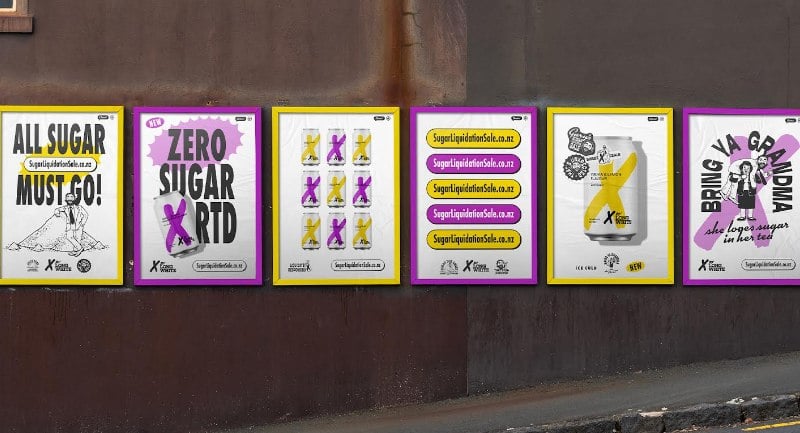Monday November 3, 2025
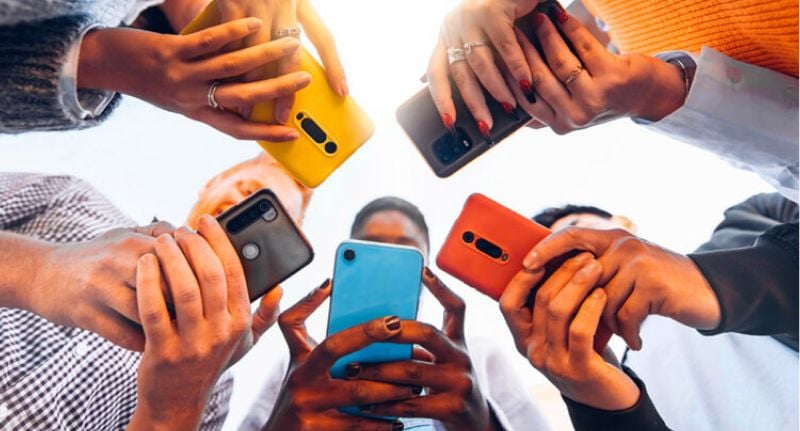
Australians are paying more for content but consuming less than ever
Australians are paying more for entertainment than ever, yet consuming less of it. It’s a decisive catch-22 pivot away from our “always-on” culture and towards selective, purpose-led viewing.
That’s according to Deloitte’s latest Media & Entertainment Consumer Insights report (MECI 2025) which points to a market breaking old habits and reshaping value expectations.
Deloitte Australia Telecommunications, Media & Technology Lead Partner Peter Corbett frames it as a behavioural milestone: “Australians are paying more for entertainment than ever before, but spending less time consuming it. MECI 2025 captures a nation rethinking its relationship with media, technology, and time.”
The implications? Pricing power meets real pressure, scrolling slows, and attention becomes a privilege, not a given.
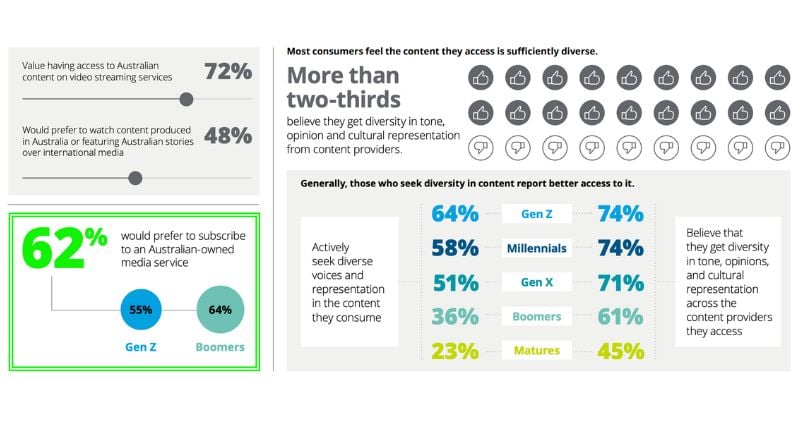
Subscriptions climb, value anxiety grows
Subscription stacks continue to rise, with Aussie households now holding an average 3.7 services, the biggest lift since COVID, and monthly spend jumping 24%. Gen Z leads with $101 per month, treating entertainment almost as a utility.
That abundance comes with fatigue.
65% of respondents now feel they need multiple services just to access what they want. As Corbett notes, “The number of streamers in the Australian market has continued to expand, with the content Australians want to watch increasingly spread over multiple providers.”
It’s little surprise nearly half of consumers say they’re open to bundling or aggregation, if anyone can do it well.
“The complexity and expense of managing multiple subscriptions means almost half of consumers say they are interested in an aggregation service,” Corbett said. “It suggests there is an opportunity in the market.”
In other words: the bundling era is here, and it may reshape power centres all over again.
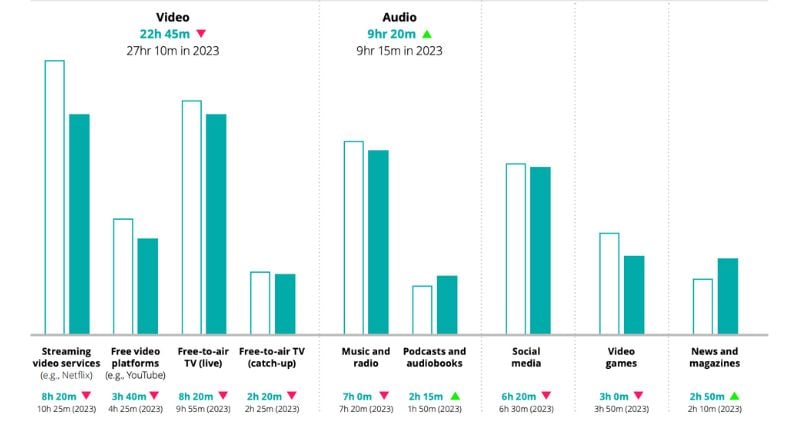
Attention contracts, audio expands
Despite higher spend, engagement time continues to fall, 42 hours and 45 minutes weekly, down 3.4%, as Australians choose experience over algorithm.
The biggest retreats:
• News/magazines: -26%
• Social media: -16%
• Video: -13%
Screens are slipping. Audio is soaring – up 34%, now 29% of all digital media time.
“To adopt Gen Z parlance, Australians are ‘learning to touch grass’ or disconnect from technology,” Corbett said.
And audio? It’s the exception. “Audio is the noticeable exception, with younger Australians spending more time streaming music and podcasts while older Australians still prefer the radio.”
This is not a fleeting correction, it’s a warning bell that a long-term rebalancing is in the works.
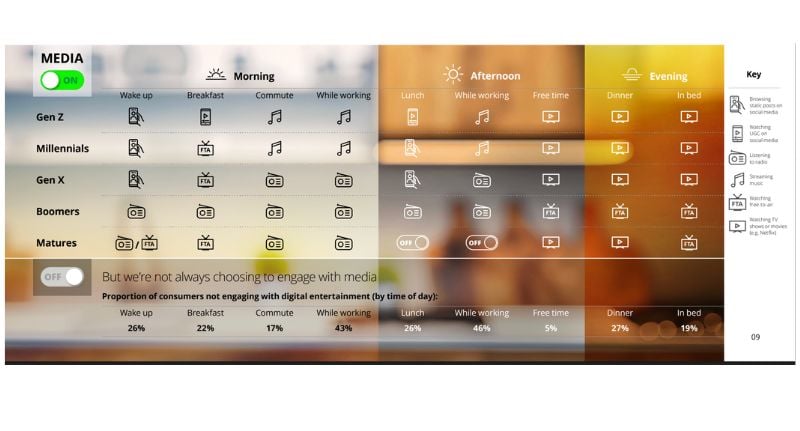
Social fatigue meets regulation reality
Social time is down a full hour per week across every cohort except Boomers, with parents driving a cultural and political shift in expectations.
“Parents want stronger rules and regulations governing children’s access to social media as well as greater support from government and industry,” Corbett said.
The upcoming Online Safety Minimum Age Bill plugs into real momentum: legislative will, plus voter appetite. It’s a structural shift, platforms are moving from growth engines to regulated utilities.
Still, trust dynamics matter. “Australians trust domestic publishers the most: more than three in four consumers consider national and regional Australian news publishers moderately or very trustworthy.”
• Social remains powerful – but its halo has burned off.
• Sport still anchors loyalty – but generational competition heats up
Sport is one of the few irreplaceable content categories, with 57% of Aussies willing to pay. AFL tops the table at 42%, but younger fandoms show the future is more diverse.
“AFL shouldn’t rest on its laurels and needs to continually engage young fans because its popularity is virtually neck-and-neck with soccer among Gen Zs and Millennials,” Corbett said.
Meanwhile, women’s sport continues to grow, driven by, perhaps unexpectedly, male fans. “Australians, and particularly Australian men, are now enthusiastically embracing women’s sport.”
Investment, access, and visibility will define who wins that momentum.
For streamers, the growth era built on “more subs, more content” has given way to something trickier: keeping audiences, not just signing them.
Publishers are rediscovering the fundamentals: trust, usefulness, and a clear value exchange. Audio, once a supporting act, is starting to look like the format built for modern attention spans and modern routines. And for platforms, the age of self-regulation is closing fast. Guardrails are coming… and communities want them.

Spotify turns ARIAs into global stage with first-ever in-app voting blitz
Spotify is taking its support for Australian music global, rolling out its biggest local ARIA Awards campaign yet across both physical and digital channels.
The streaming giant has launched more than 800 out-of-home placements across Australia and key markets including the US and UK, alongside a first-of-its-kind in-app voting feature for ARIA categories.
The campaign celebrates 2025 ARIA nominees and reminds fans they can cast votes directly in Spotify, with several billboards featuring QR codes that link straight to the voting hub.
Winners will also appear on international billboard screens after the ceremony on Wednesday 19 November, with Times Square and London’s Leicester Square confirmed among the locations.
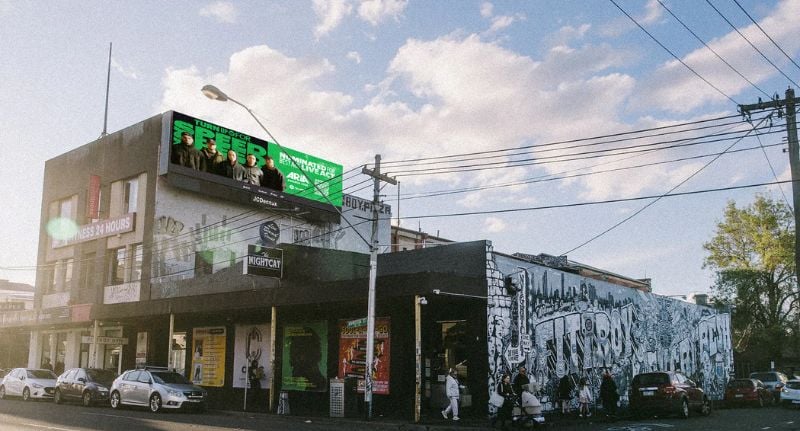
In-app voting drives fan engagement
For the first time in Australia, Spotify has embedded ARIA public voting directly into playlists across four categories: Best Australian Live Act, Song of the Year, Best Video and Most Popular International Artist.
Since launch, more than 250,000 Australians have cast votes via the platform, surpassing vote totals from the past two years combined. Voting also remains available on the ARIA site.
The ARIA Awards Hub sits front-and-centre in the app, housing voting playlists, nominee spotlights and curated collections celebrating both emerging and legacy talent.
Spotify says the push has already delivered hundreds of thousands of extra streams for nominees.
“The ARIA Awards 2025 campaign is Spotify’s most extensive local on platform promotion ever,” said Rosie Rothery, Head of Marketing, Spotify ANZ.
“We’ve flexed the power of our platform and global footprint to put Australian artists and their success stories front and centre.”
Supporting Australian music at home and abroad
ARIA chief executive Annabelle Herd said the partnership amplifies Australian artists at a critical time.
“The ARIA Awards 2025 are shaping up to be the biggest global platform to date for the incredible Australian artists making waves in culture around the world,” she said. “This is what Aus music looks like on the world’s stage.”
Alongside OOH and in-platform integrations, the campaign includes social content and an ARIA Awards Spotify Artist Party.
OOH Campaign Credits
Akcelo:
Aden Hepburn – Founder & CEO
Louise McQuat – Global Creative Director
Dave Di Veroli – Chief Strategy Officer
Oli Cassidy – Client Partner
Matty Graham – Business Lead
Sammy Stack – Senior Account Manager
Jay Morgan – Creative Director
Tom McMullan – Senior Creative
Henry Wall – Senior Creative
Grga Calic – Senior Creative
Daniel Burns – Producer
Stephen Au – Lead Designer
Justin Bellchambers – Head of Post
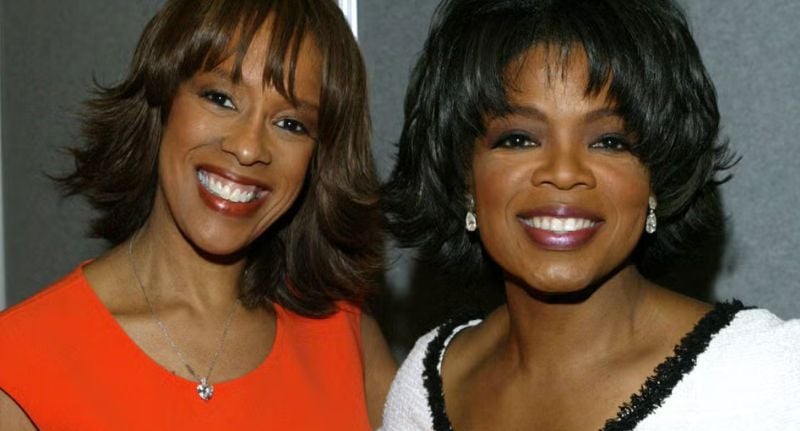
Claims Oprah's bestie Gayle King getting the boot from CBS Mornings
Rumours around Gayle King’s future at CBS Mornings in the US have kicked into overdrive, but the network’s long-standing anchor isn’t rushing to pack up her desk.
And in true morning-TV fashion, she’s doing it with a smile, even as CBS’s parent company undergoes one of the biggest leadership and content shifts in its modern history.
King pushes back on exit chatter
Caught outside CBS’s New York studio on Friday, King clarified she’s still very much in the chair, telling website TMZ, that from what she’s hearing, she’s not only doing a great job, but she’s well-liked at CBS.
Her take? The newsroom whispers don’t match the headlines.
While not fully ruling out a future move, King said she “has no idea” whether CBS Mornings plans to pivot when her deal expires in May 2026, emphasising she “loves what she does and the coworkers with whom she does it.”
And right now, she intends to keep doing exactly that.
CBS backed her up, issuing a rare on-the-record response: “There have been no discussions with Gayle about her contract that runs through May 2026. She’s a truly valued part of CBS and we look forward to engaging with her about the future.”

A contract end
Behind the scenes, the picture is more complicated than a casual sidewalk chat.
Four industry sources say King is expected to exit the anchor chair next year as part of a broader shake-up at CBS News under new Paramount-Skydance leadership.
Her contract is reportedly up in May, with options on the table, including a potential new role focused on developing original programming for the network.
Paramount Global and Skydance Media finalised their long-negotiated merger back in August. The deal was valued at around US$8 billion, with the newly combined company will be named ‘Paramount, A Skydance Corporation.’
It begins trading on the Nasdaq under the ticker PSKY, with David Ellison taking the role of chairman and CEO, and Jeff Shell named president.
The transaction follows the US Federal Communications Commission’s approval on 24 July, more than a year after the merger was first announced in July 2024.
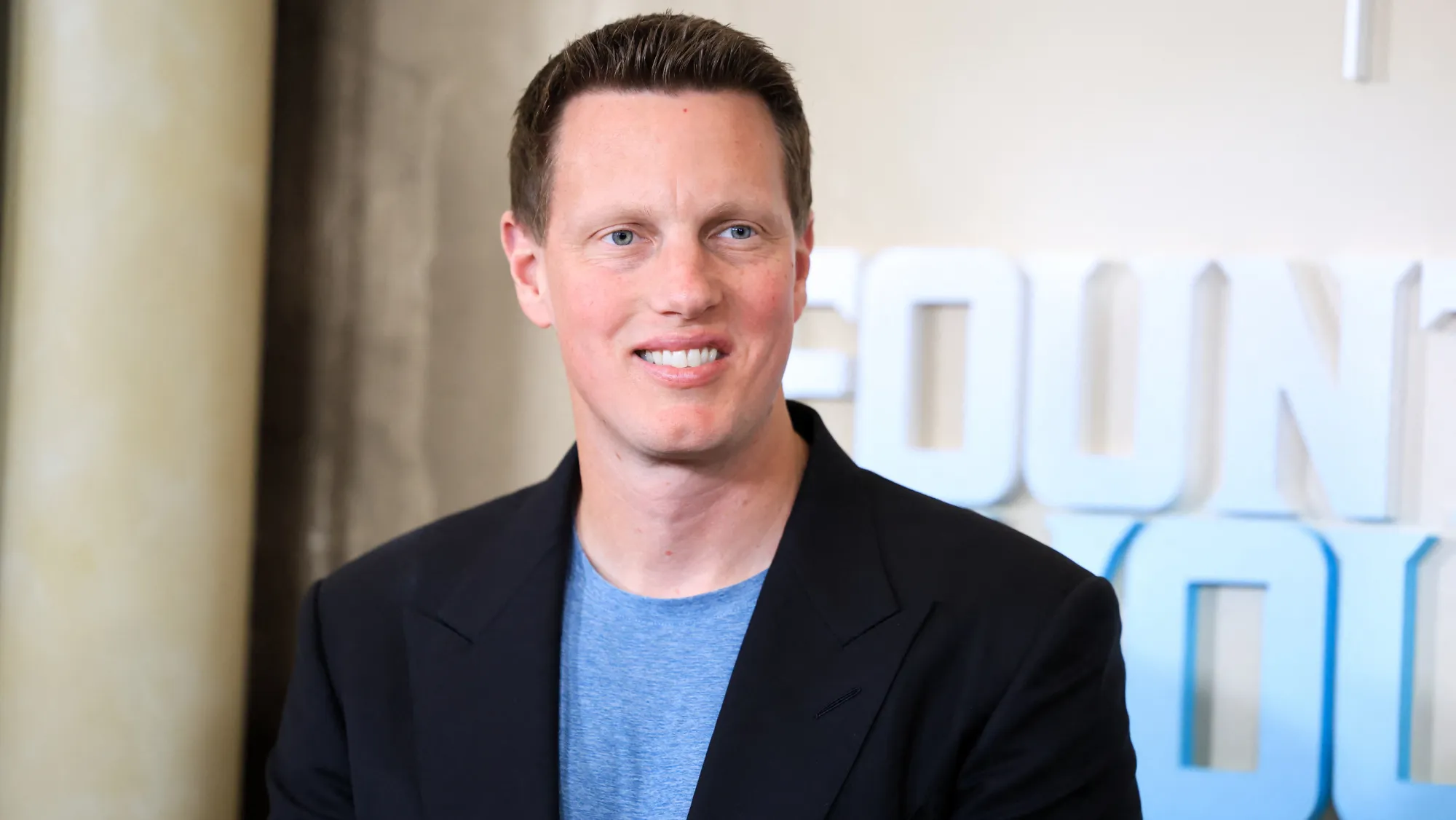
Paramount, A Skydance Corporation CEO David Ellison
A newsroom in flux under Skydance
The reported conversations come as Paramount’s ownership formally shifts from the Redstone era to the Ellisons, with a stated ambition to reshape CBS News’s editorial tone.
Bari Weiss, the founder of conservative-leaning outlet The Free Press, was recently installed as editor-in-chief.
Layoffs are already rolling through the business, with dozens leaving the news division and hundreds more cuts expected across the company.
CBS has also moved to sunset one of its most well-known franchises, announcing The Late Show with Stephen Colbert will end in May, a symbolic marker for the network’s post-sale reset.

Adland applauds Canberra’s copyright call
Adland has hailed the federal government’s refusal to relax copyright laws for AI platforms as a rare victory for creators.
The Productivity Commission proposed a fair dealing exception for text and data mining, claiming a mature data-sharing regime could boost Australia’s economy by $10 billion.
Attorney-General Michelle Rowland said there are “no plans” to weaken protections and urged the tech industry and creative sector to find “sensible and workable solutions.”
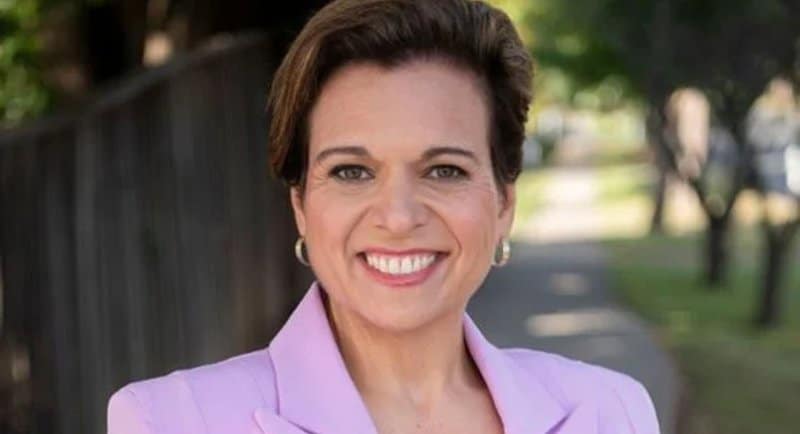
Creators welcome a rare win
Ellie Fraser, communications planner at BCM Media, said she’s glad to see the government stand firm on this.
“Every idea, headline, and visual comes from real people putting in hours of thinking, experimenting and refining – so I think it’s only fair that the people behind the work are recognised and compensated, rather than having their thinking quietly absorbed into AI systems,” she said.
“While I’m all for innovation and genuinely excited by the potential of AI, I totally agree with the sentiment of the article that progress shouldn’t come at the expense of the people whose work trains these systems.
“Creativity has value – not just commercially, but culturally, so it deserves to be protected.”
Shai Luft, co-founder of Bench Media, welcomed the government’s decision, calling it “the right kind of restraint.”
He said too many tech companies treat creative work as free fuel, scraping articles, music and campaigns under the banner of innovation.
“If your AI needs to steal ideas to be smart, maybe it’s less intelligent than you thought,” he told Mediaweek.
“Australia now has a chance to chart a better path, built on consent-based collaboration between publishers, agencies and AI developers.”
Luft believes in paying for quality data, partnering with creators and building systems that respect the source material.
“This isn’t anti-AI. It’s pro-integrity. You can’t build the future of intelligence on the theft of creativity,” he said.
“In an industry where originality and trust drive value, that distinction matters more than ever.”
Ethics and the value of creativity
Angus Wright, SEO and website executive at Yango, believes strong copyright laws are crucial to protect the rights and work of creators, journalists and artists.
“This upholds the core principle that intellectual property has value and that creators deserve compensation, rather than supporting the creation of AI models,” he said.
“The legality of permission for AI platforms to train on these publicly accessible platforms remains ambiguous and a major challenge, leaving original rights-holders vulnerable even if copyright laws are being upheld.
“The next phases of lawmaking will be critical in protecting IP in the future.”
Amy Tucker, co-founder of Springboards, thinks it’s the right idea, but maybe the wrong scale.
“Protecting creators is crucial, but without a coordinated global approach, we’re mostly making a point, not a difference,” she said.
“The companies doing real AI training are already overseas and this will just keep it that way and might push any Australian startups and talent to head overseas.”
Jordan Taylor-Bartels, CEO of Prophet, said this is “a much-needed lifeline” for publishers.
He believes the government should help them build new IP contracts and commission systems so journalism can capture value in an AI era.
“Let publishers license their archives, negotiate rights-for-training models and earn from AI’s appetite for trusted input. And maybe then we will see journalism treated less as an expense, and instead as an asset.
“If they don’t, we all may as well call it quits now and save everyone the time.”

Balancing innovation with protection
Adrian Elton, an independent creative, said many in the industry have “a visceral hatred of AI” and the “dumbing down of hard-earned skills that were never meant to be accessible to all.”
“There is also a considerable tribe of fluent, capable, deeply skilled creatives who are simultaneously intrigued by how these new tools can super-charge their creative practice,” he said.
“For me, that’s all about being able to bring completely original concepts to life that would have otherwise required major investment and the support of tight-fisted gatekeepers.”
Elton added that Australia has “chosen wisely, as opposed to expediently” by setting boundaries.
“Just because big-tech wants to snaffle up everything for nothing, doesn’t mean it has any kind of natural right to it,” he said.
“Artists, musicians and writers, and any kind of creators of intellectual property, should not only be compensated for the use of their work, but ideally it should only be ‘sampled’ subject to an opt-in licensing arrangement.”
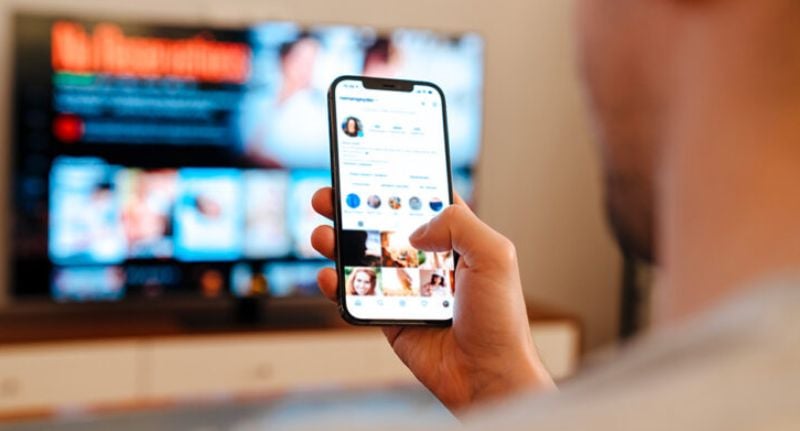
OzTAM expands reporting as younger audiences shift screens
OzTAM’s latest quarterly viewing data shows broadcast television remains the backbone of Australian video consumption – but younger audiences are increasingly favouring digital platforms, reinforcing agency calls for cross-platform currency and deeper verification.
Across July to September, broadcast TV accounted for 59.8% of viewing among total people. Total BVOD sat at 9.3%, while digital video – including Netflix, YouTube, Disney+, and Prime Video – held steady at 30.9%.
In the commercial heartland, the balance has shifted.
Streaming (digital video + BVOD) now commands 53.9% among 25–54s, compared to broadcast at 46.1%.
Men 18–39 spend more than half their time with digital video, while women 18–39 recorded the highest BVOD share across all demos at 17.7%.
It’s the generational carve-out agencies have anticipated: older audiences hold firm in traditional habits; younger cohorts jump across platforms – and buyers need flexible, unified proof to follow them.
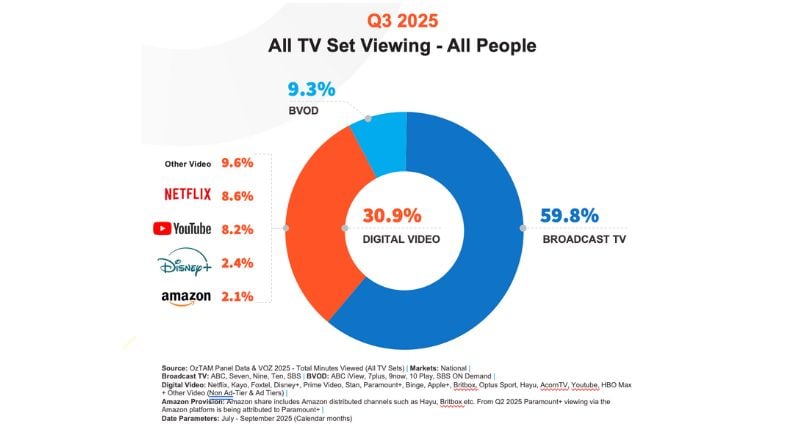
Netflix leads, YouTube gains ground
Netflix remained the top streaming platform at 21.3% share of minutes viewed, while YouTube rose to 20.5%, driven by men 18–39, who lifted to 24.1%.
The dynamic underscores a market balancing premium long-form environments and algorithm-driven scale – a tension shaping media mix conversations across holding groups.
More demos, sharper decisions
Now in its third iteration, the quarterly release has expanded from five core demos at launch to 21 demographic segments, giving subscribers more precise audience slicing.
“As Australians continue to explore more ways to watch, Streamscape provides a unified view of where attention goes and how that changes over time,” OzTAM CEO Karen Halligan said.
“The growing depth of demographic detail allows advertisers and media partners to plan and measure with far greater insight and we look forward to this continuing as this evolving product continues to mature.”
Streamscape is provided quarterly to subscribers, with monthly and quarterly snapshots across TV sets.
Reporting will expand in 2026 to include smartphones, tablets, and computers, and shift to a digital interactive dashboard in the first half, a move aimed at deepening planning tools as scrutiny around CTV measurement intensifies.
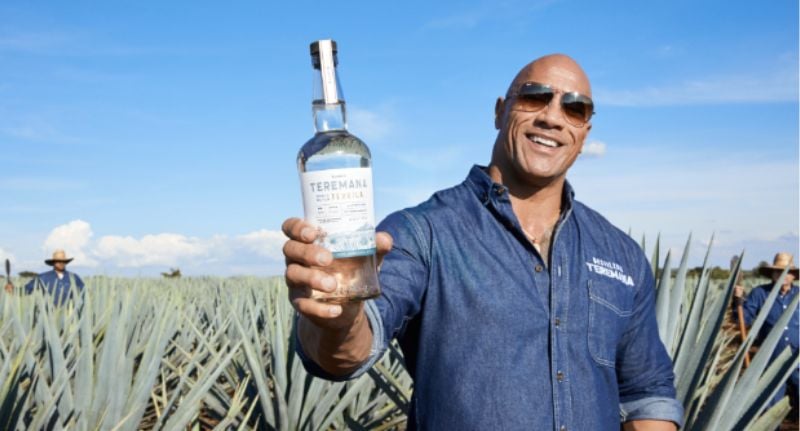
Inside The Rock's Aussie tequila tour: gratitude over glitz
You might expect flashy parties and fanfare when Dwayne “The Rock” Johnson’s tequila brand hits the road, but the Australian leg of Mana on the Road was all about gratitude.
Teremana’s global brand ambassador Alan Ruesga-Pelayo said the idea came from a lifetime spent behind the bar.
“I’ve learned that hospitality always begins with gratitude,” he told Mediaweek.
“Mana on the Road grew out of that same feeling – that sometimes the most powerful thing you can do is say thank you.”
At the heart of the activation is the Mana Mailbox, a space where guests can slow down, write a postcard to someone who inspires them and send a bit of good energy their way.
“You can’t see mana, but when someone says thank you, you can feel it,” says Ruesga-Pelayo.
“And that’s what this tour is all about – sharing that feeling, one postcard and one toast at a time.”
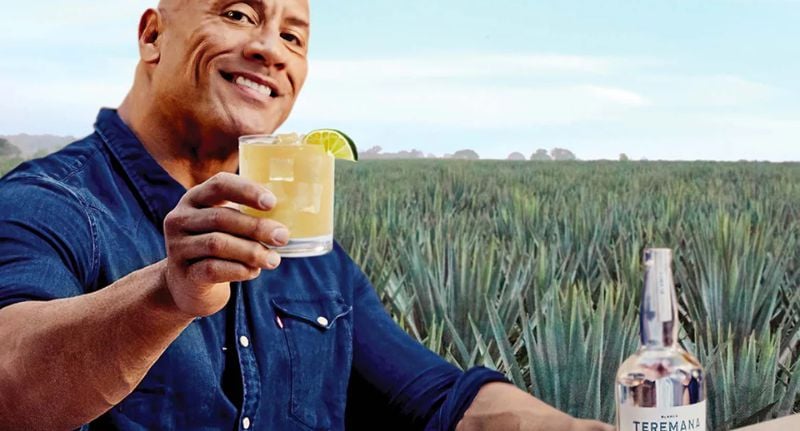
Bringing mana to Australia
Mana on the Road celebrated the unsung heroes who keep communities moving and “never stop showing up.”
Ruesga-Pelayo said the tour mirrors Teremana’s core values.
“For me, Mana on the Road was the perfect reflection of what Teremana stands for – good energy, connection and doing things the right way,” he said.
Every stop from Sydney to Brisbane gave guests a chance to engage with the brand in a meaningful way.
“We didn’t show up to sell tequila; we showed up to share gratitude,” he added.
“When people walk away smiling, feeling seen and maybe holding a postcard for someone they love… that’s when I know we’re truly sharing the mana.”
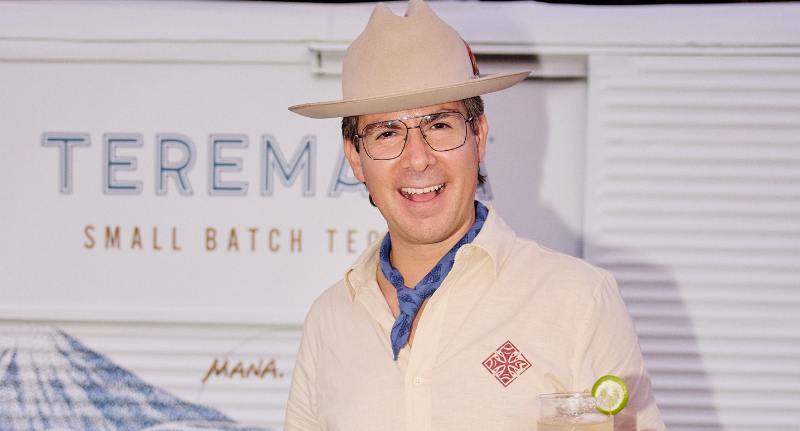
Connection before commerce
In an era where marketing often shouts louder than it listens, Teremana is focussed on creating genuine emotional connections rather than product-centric messaging.
“I’ve learned that people might forget a recipe, but they never forget how you made them feel,” said Ruesga-Pelayo.
He said putting people first makes the craft itself more meaningful.
“Of course we care deeply about craft – the brick ovens, the copper stills, the slow process – but that care means more when it starts with people,” he added.
“Gratitude is the first ingredient; tequila just helps us share it.”
Measuring hearts, not just heads
Most brands measure success in clicks and conversions, but Teremana takes a different approach.
“Anyone can count heads – we count hearts,” said Ruesga-Pelayo.
The team collected more than 500 handwritten postcards over the course of the Australian tour.
“Every one of those cards carries a story of gratitude – and that, to me, is the real measure of success,” he added
“Of course, we still track the tangible results – new menu placements, training and relationships that grow from those experiences – but those numbers only matter because of the feeling behind them.”

From Hollywood to the bar
Johnson’s global presence gives the brand instant recognition, but Ruesga-Pelayo says keeping it human is key.
“Dwayne’s vision gave us the foundation – a tequila made the right way and built on good energy – but my role, and our team’s role around the world, is to keep that spirit human and connected,” he said.
“He opens the door; it’s up to us to fill the room with mana.”
Ruesga-Pelayo said the goal is to make every guest feel seen and welcome.
“Wherever we go – whether it’s a small bar in Mexico, a rooftop in New York or the beaches of Australia – we lead with authenticity: slow brick-oven roasting, open-air fermentation, small-batch copper pot stills and a genuine respect for people,” he said.
Built on purpose, not promotion
With celebrity-backed spirits flooding the market, Teremana aims to stand apart by staying true to its roots.
“What sets Teremana apart is that it was built on purpose before promotion,” said Ruesga-Pelayo.
“We make tequila the old-school way… and we do it all at our own distillery You can taste the patience in every sip.”
Ruesga-Pelayo said that beyond the craft lies something more intangible: what he calls “good energy.”
“Many brands talk about image; we talk about gratitude. That’s why, wherever we go in the world, people don’t just taste Teremana, they feel it,” he said.
“There’s good energy behind this brand – the kind that starts with our founder’s vision and continues through every bartender, every guest, every postcard written at the Mana Mailbox.”
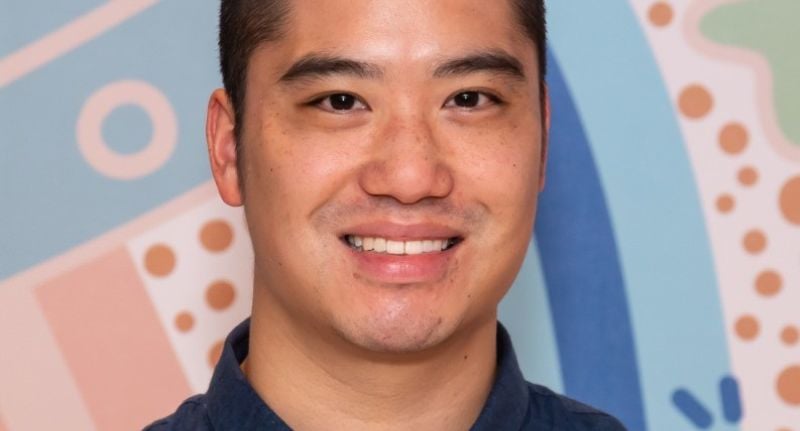
The secrets to networking like a pro on LinkedIn
Brendan Wong, LinkedIn Career Expert
“For many professionals, even in media, networking online can feel daunting, like stepping into a room full of strangers with no idea where to begin. But in today’s world, your career success often comes from the strength of your network and the doors those connections can open.
Whether you’re looking for a new role, career advice or industry insights, nobody wants to waste time on awkward, one-off exchanges. The good news? Networking doesn’t have to feel forced.
Think of it like Australia’s favourite ritual – grabbing a coffee. It’s casual, it’s social, and it’s about connection. You don’t rush through it; you take the time to enjoy the conversation. Networking works the same way.
Here are some practical tips and tools to make every connection count:
Start with a chat, not a pitch
When you meet someone for coffee, you don’t launch into a sales pitch – you start with a genuine conversation. Networking on LinkedIn should feel the same.
Join discussions already happening in your feed. If someone in your network posts something interesting, leave a thoughtful comment or share your perspective. It’s a natural way to reconnect without feeling transactional.
Before you reach out, take a few minutes to check their recent posts. It shows you’ve done your homework and helps you find common ground.

Make it a habit
Just like your morning flat white, networking works best when it’s part of your routine. Instead of waiting until you need something, build small habits into your week – comment on a post, send a quick congratulations, or share an article that might interest someone in your network.
A few pro tips
Personalise your outreach: Mention a shared interest or congratulate someone on a recent milestone.
Be specific: Instead of saying, “I’d love to pick your brain,” outline a few topics you’d like to discuss and why their perspective matters.
Keep it short and authentic: Think of your elevator pitch as a quick intro over coffee – clear, personal and memorable.
Use the right tools
LinkedIn offers features that make networking easier and more effective.
Catch Up tab: In the My Network section, this highlights when a connection starts a new job, celebrates a work anniversary, is hiring or even has a birthday – perfect conversation starters.
AI-powered writing assistant: This tool can help you draft personalised messages by surfacing shared interests and insights, so you can focus on making the message feel authentic.
Profile optimisation: Make sure your profile tells your story clearly – your About section, skills and featured content should reflect your expertise and personality.
Networking today is less about cold outreach and more about building authentic relationships. So, start small, stay consistent, and use the right tools to make every connection count.”
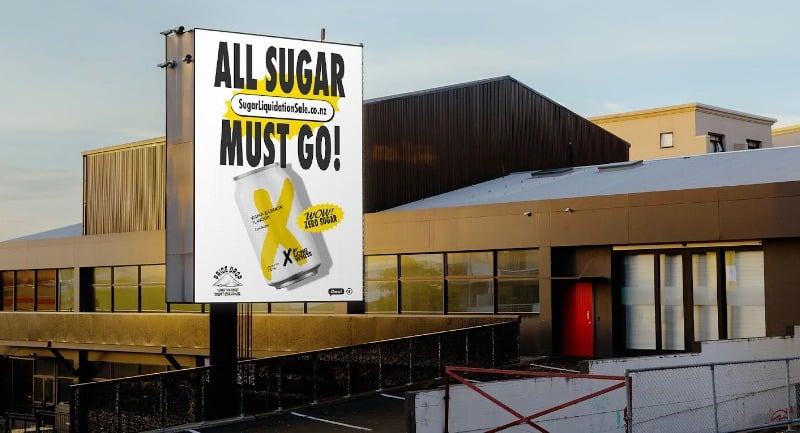
Droga5 helps Long White launch sugar-free range with ‘liquidation sale’ stunt
Asahi Beverages NZ has launched X by Long White, a new sugar-free sub-range of its popular RTD brand, with an unexpected twist – a campaign that sees the brand selling off its leftover sugar.
Created by Droga5 ANZ, part of Accenture Song, the integrated campaign introduces a new brand platform, That’s Unxpected, designed to challenge category conventions and celebrate the brand’s playful spirit. The launch centres on Gary’s Sugar Liquidation Sale, a nostalgic 90s-style retail concept that brings humour to the sugar-free message.
The campaign’s story follows Gary, a well-meaning salesman attempting to offload “mountains” of sugar left over after Long White’s reformulation. The campaign rolled out across outdoor, digital, broadcast and social, including a teaser phase that built anticipation for the sale before expanding to national OOH and film assets featuring Gary’s chaotic escapades.
A retro website created by Droga5 ANZ, complete with widgets, lo-fi design and a jingle-driven radio ad, brings the concept online. Fans can even call 0800 4SUGAR to leave offers for Gary directly, extending the humour across touchpoints.
To reach younger audiences, Gary has also made his way into the villa through partnerships with Love Island Australia and TVNZ, appearing in idents and Ad on Pause assets throughout the season. A limited-edition merchandise capsule branded with Gary’s Liquidation Sale artwork is also being shared with fans and trade partners.
Tatyana Dickson, General Manager – Marketing, Asahi Beverages NZ, said the campaign was about reclaiming Long White’s place in Kiwi social culture. “It’s all about showing up in unexpected ways and reminding New Zealanders that Long White is synonymous with good times. X by Long White gives our drinkers the same great taste they love, now in a sugar-free option — without losing any of the fun.”
Christie Cooper, Executive Creative Director, Droga5 ANZ, added: “With summer fast approaching and competition in the light RTD category heating up, going out with expected messaging in a sea of sameness just wasn’t an option. Instead, we asked ourselves: what’s the most unexpected way to celebrate a sugar-free drink? The answer was simple: sell the sugar.”
James Conner, Executive Creative Director, Droga5 ANZ, said the campaign brings “humour, nostalgia and genuine Kiwi charm to the category. It’s fun, self-aware, and undeniably Long White.”
X by Long White is now available nationwide in New Zealand, with Gary’s Sugar Liquidation Sale running across digital, OOH, social, radio and broadcast partnerships throughout the summer.
CREDITS:
Client: Asahi Beverages NZ Limited
GM Marketing: Tatyana Dickson
Marketing Manager – Light RTD’s: Jonathan Rea
Senior Brand Manager: Monique O’Neil
Creative Agency: Droga5 ANZ, part of Accenture Song
Chief Creative Officer: Damon Stapleton
Executive Creative Director: Christie Cooper & James Conner
Chief Strategy Officer: Stevie Weber
GM & Executive Producer: Rosie Grayson
Group Business Director: James Allan
Art Director: Zac Nairn
Copywriter: Casey Clarke
Design Lead: Lucinda Fortescue-Hansen
Designer: Vivian Heng
Finished Artist: Lisa Stowers
Integrated Producer: Callum Crabb
Production Company: Reel Factory
Director: Ryan Heron
Executive Producer: Dan Watkins
Producer: Pippa Keiller
Composition and Sound Design: Cam Ballantyne, Beatworms
Design: One Design
Illustration: Blair Sayer, Watermark

Alyssa Delpopolo wins The Voice 2025
Australia has a new Voice, and she’s barely out of high school. Nineteen-year-old Sydneysider Alyssa Delpopolo has taken out The Voice 2025 title on Seven.
Sonia Kruger delivered the big moment; Delpopolo stood frozen, shell-shocked, as the result landed.
“It doesn’t feel real at all,” she said – breathless, wide-eyed, and suddenly $100,000 richer with a full recording development package in tow.
Kate Miller-Heidke, who guided her to the finish line, looked just as stunned. “Australia loves you as much as I do, and I’m so thrilled. We did it!”

A Voice journey that started in the audience
Delpopolo’s win felt like lightning in a bottle, a season-long arc built on instinct and a little serendipity. Her journey began not on stage, but in the crowd.
Singing during a break caught the attention of Coaches and prompted an invitation to the Blind Auditions from both Miller-Heidke and Ronan Keating.
She first chose Team Ronan, then later switched to Team Kate after the Battles round – a savvy move that paid off.
Her finale performance of Celine Dion’s It’s All Coming Back To Me Now drew a standing ovation from all four Coaches.
Judge Richard Marx didn’t hedge: “That was stunning. I think even Celine would sit here and go, wow! That was incredible.”
Miller-Heidke added, “To see you in all of your glory. Standing there in all of your power. It’s transcendent.”
Duets, and emotion
Finale night delivered all the trimmings, including an emotional duet between Delpopolo and Miller-Heidke on Selena Gomez’s Lose You To Love Me – soft, angelic, tightly controlled.
Fellow finalists Bella Parnell, Cassie Henderson and Cle Morgan also closed strong, a reminder why this all-female final four landed as one of the season’s most-talked-about moments.
The industry-watchers in the wings will now shift to the next phase: can Seven convert talent momentum into chart traction and streaming heat?
It’s one thing to win The Voice; it’s another to move units in a cluttered music market. But Delpopolo arrives with vocal power, narrative punch, and a ready-made fan base.
It’s a compelling combo in a streaming-first world.
Media
Gina Rinehart eyes Nine Radio play
According to The Australian’s Steve Jackson, Rinehart has quietly kicked the tyres on Nine’s radio assets as the company edges toward an expected block sale of its talk network.
Think the big four: 2GB, 3AW, 4BC and 6PR.
Stephen Conroy joins Foxtel’s reshaped board
The Australian Financial Review’s Sam Buckingham-Jones writes that former communications minister Stephen Conroy has scored a board seat as DAZN beds in its takeover of the pay TV group and starts retooling the leadership mix.
Advertising
Aussies lean into pet birthdays and card culture
Moonpig says more than 10,000 pet birthday cards were snapped up locally in the first nine months of the year.
The company’s international lead Alex Toft says Aussies buy cards for more occasions than most markets, which is exactly why the UK-born brand planted a flag here two years ago.


